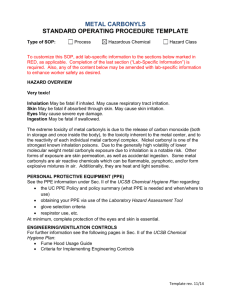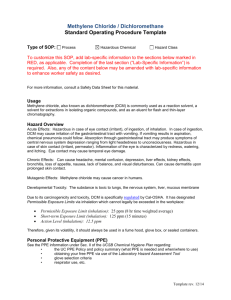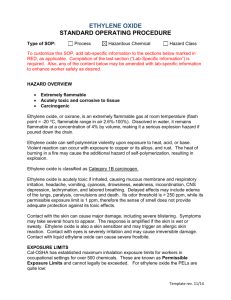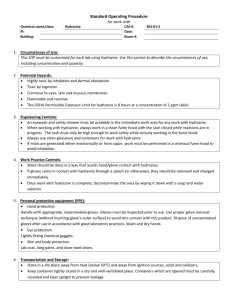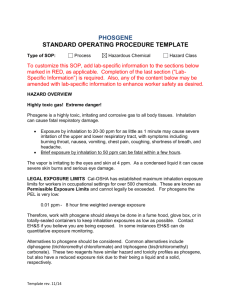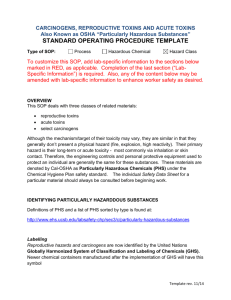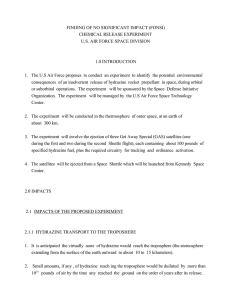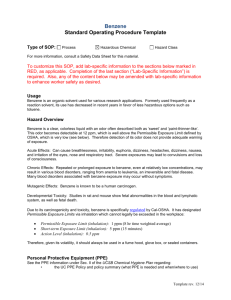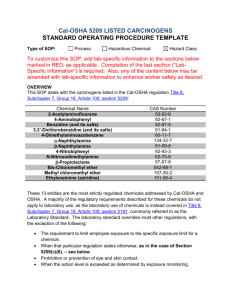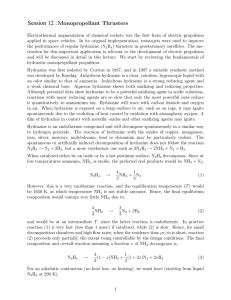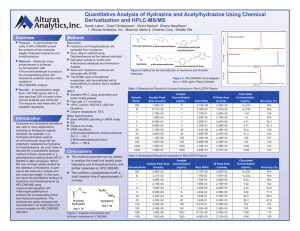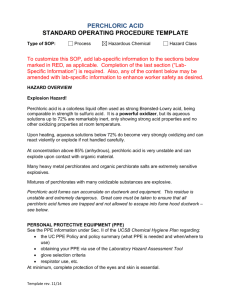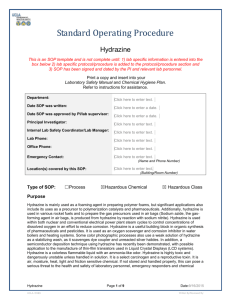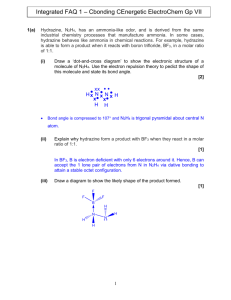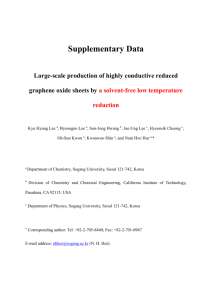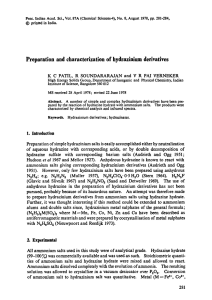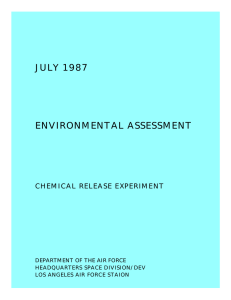Hydrazine
advertisement
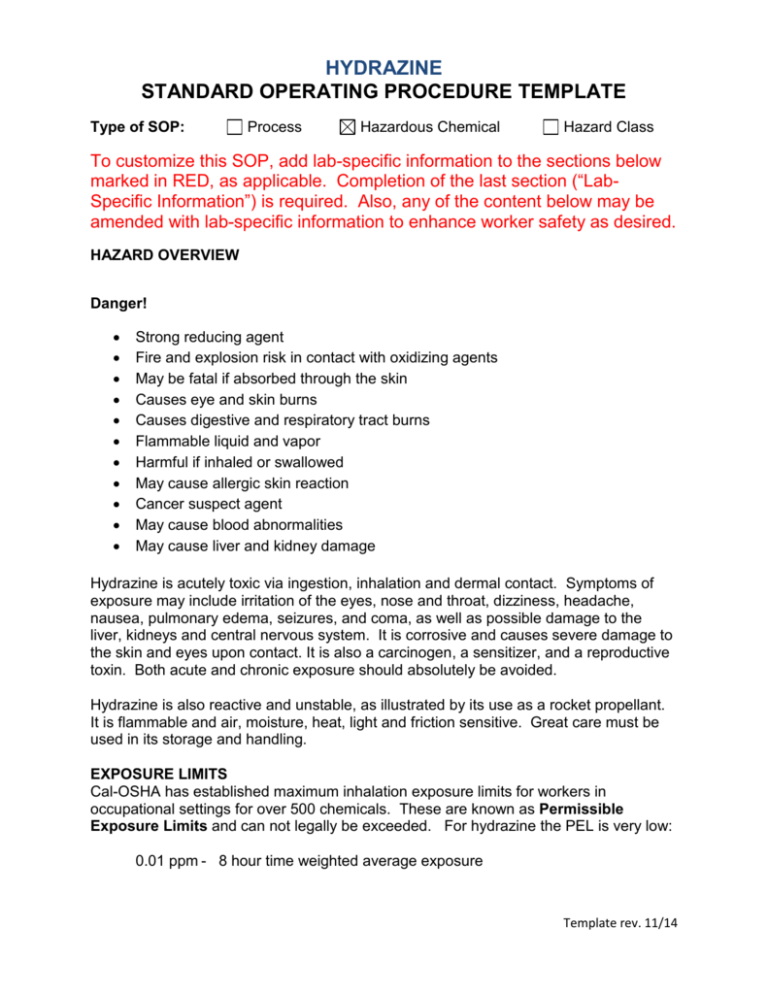
HYDRAZINE STANDARD OPERATING PROCEDURE TEMPLATE Type of SOP: Process Hazardous Chemical Hazard Class To customize this SOP, add lab-specific information to the sections below marked in RED, as applicable. Completion of the last section (“LabSpecific Information”) is required. Also, any of the content below may be amended with lab-specific information to enhance worker safety as desired. HAZARD OVERVIEW Danger! Strong reducing agent Fire and explosion risk in contact with oxidizing agents May be fatal if absorbed through the skin Causes eye and skin burns Causes digestive and respiratory tract burns Flammable liquid and vapor Harmful if inhaled or swallowed May cause allergic skin reaction Cancer suspect agent May cause blood abnormalities May cause liver and kidney damage Hydrazine is acutely toxic via ingestion, inhalation and dermal contact. Symptoms of exposure may include irritation of the eyes, nose and throat, dizziness, headache, nausea, pulmonary edema, seizures, and coma, as well as possible damage to the liver, kidneys and central nervous system. It is corrosive and causes severe damage to the skin and eyes upon contact. It is also a carcinogen, a sensitizer, and a reproductive toxin. Both acute and chronic exposure should absolutely be avoided. Hydrazine is also reactive and unstable, as illustrated by its use as a rocket propellant. It is flammable and air, moisture, heat, light and friction sensitive. Great care must be used in its storage and handling. EXPOSURE LIMITS Cal-OSHA has established maximum inhalation exposure limits for workers in occupational settings for over 500 chemicals. These are known as Permissible Exposure Limits and can not legally be exceeded. For hydrazine the PEL is very low: 0.01 ppm - 8 hour time weighted average exposure Template rev. 11/14 Therefore, work with hydrazine should always be done in a fume hood, glove box, or in totally-sealed containers to keep inhalation exposures as low as possible. Contact EH&S if you believe you are being exposed. In some instances EH&S can do quantitative exposure monitoring. Because hydrazine is also a serious skin contact hazard, skin exposure should also be minimized. PERSONAL PROTECTIVE EQUIPMENT (PPE) See the PPE information under Sec. II of the UCSB Chemical Hygiene Plan regarding: the UC PPE Policy and policy summary (what PPE is needed and when/where to use) obtaining your PPE via use of the Laboratory Hazard Assessment Tool glove selection criteria respirator use, etc. At minimum, complete protection of the eyes and skin is essential. 0.1mm Nitrile rubber gloves may be used to protect from incidental splashes. ENGINEERING/VENTILATION CONTROLS For further information see the following pages in Sec. II of the UCSB Chemical Hygiene Plan: Fume Hood Usage Guide Criteria for Implementing Engineering Controls SPECIAL HANDLING PROCEDURES AND STORAGE REQUIREMENTS Handling 2 Wash thoroughly after handling. Remove contaminated clothing and wash before reuse. Ground and bond containers when transferring material (i.e., if in a metal container). For safety reasons, transfer from glass to glass container using proper techniques (often purged with nitrogen). Never add water to this product. Avoid shock and friction. Explodes on contact with barium oxide, calcium oxide, chromate salts and many other substances. Use spark-proof tools and explosion proof equipment. Do not get in eyes, on skin, or on clothing. Empty containers retain product residue, (liquid and/or vapor), and can be dangerous. Keep container tightly closed. Do not ingest or inhale. Do not pressurize, cut, weld, braze, solder, drill, grind, or expose empty containers to heat, sparks or open flames. Keep away from heat, sparks and flame. Use only with adequate ventilation or respiratory protection. Storage Keep locked up. Keep container dry. Keep away from heat, sparks & flame. Keep away from sources of ignition. Keep away from acids and moisture. Do not store in direct sunlight or strong incandescent light. Storage under a nitrogen blanket has been recommended OR inside a glove box (under inert atmosphere). Isolate from oxidizing materials and acids. All hydrazine containers must be stored using secondary container (tray/tub) with proper signage/caution label. Hazard communication: Warning/Caution label is required on each hydrazine container, secondary containment and designated storage cabinets/areas. Warning/Caution label must state the following: “CARCINOGEN / CANCER HAZARD or SUSPECT CANCER AGENT & Reproductive Toxin” Incompatibility 3 Substance is highly reactive reducing agent. Incompatible with oxidizing agents (including air), acids, and some metal oxides and metals. Substance may spontaneously ignite in air when in contact with porous materials. Ignites on contact with dinitrogen oxide and tetroxide, hydrogen peroxide, tetryl, and nitric acid. Explodes on contact with dicyanofurazan, n-halomides, potassium, silver compounds, sodium hydroxide, titanium compounds, and trioxygen difluoride. Explosive compounds may result from contact with air chloromethylnitrobenzene, lithium perchlorate, metal salts, methanol + nitromethane, sodium, and sodium perchlorate. Also incompatible with barium oxide or calcium oxide, benzeneseleninic acid or anhydride, calcium, carbon dioxide + stainless steel, 1-chloro-2,4-dinitrobenzene, cotton waste + heavy metals, (difluoroamino) difluoroacetonitrile, iodine pentoxide, rust, ruthenium(III) oxide, thiocarbonyl azide thiocyanate, SPILL AND INCIDENT PROCEDURES See directions under the “Chemical Incident” tab of the UCSB Emergency Information Flipchart – should already be posted in all labs. DECONTAMINATION Using proper personal protective equipment as outlined above, decontaminate equipment and bench tops using soap and water and properly dispose of all chemical and contaminated disposables as hazardous waste following the guidelines below. WASTE DISPOSAL See “Chemical Waste Disposal” in Sec. II of the UCSB Chemical Hygiene Plan. PRIOR APPROVAL/REVIEW REQUIRED As they deem necessary, the PI/supervisor should insert here any prior approval or review needed before an individual can do the operation DESIGNATED AREA As they deem necessary, the PI/supervisor should insert here any information about whether a special use-area is designated for this material/process SAFETY DATA SHEETS Found online at: http://ehs.ucsb.edu/labsafety/msds LAB-SPECIFIC INFORMATION (required) (Examples of appropriate content) Add appropriate lab-specific information here describing how this material(s) is generally used. E.g., name of protocol, typical frequency done, quantities used, temperature and any additional safety measures, etc. 4
